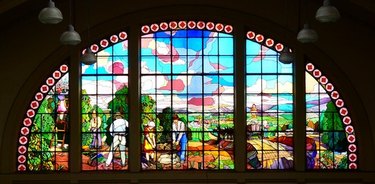
You may have bought a house that has stained glass windows, and you are trying to find out if they are original to the house. Or, you may be seeking to find out the age of the windows in your local church or library. Although it is an extensive and complex process, the best ways to find out the age of stained glass windows are to first consider the window's style and design, the type of glass used in making the window, and the type of leading and beveling used. You can also use public records to try determine who made it, and when.
Consider the Clues
Video of the Day
Step 1
Determine the style of the window. Primitive stained glass windows, for instance, are simple and unrefined, and incorporate chunks of faceted glass known as jewels or bull's eyes, which are projecting, rounded pieces of glass often serving as the center or hub of the glass. Art Noveau, which features long, curving lines, was popular at the turn of the century, and can date the window somewhere between 1890-1910, when this style was trendy. Art Deco was developed in 1925, and features geometric designs, such as triangles and sharp, angled leading.
Video of the Day
Step 2
Consider the type of glass used in the stained glass window. For instance, if opalescent glass was used in it--glass where more than one color is present--this will place the date the window was made after 1880, the year which this type of glass was patented. Slag glass--a low-grade glass which is usually amber or green--was popular in the early 1900s, and was used in many of Tiffany's productions.
Step 3
Inspecting the leading and beveling on the window will provide further clues to the date of its production. Beveled accents in stained glass windows, for example, were not frequently seen before 1875. In the early 1880s, a breakthrough in stained glass assembly allowed tiny pieces of glass to be "fastened" together without the use of lead came (lead came is lead that is shaped like the letter 'H' and allows individual pieces of glass to be fitted together). Windows with this type of leading can be placed after 1880.
Using Public Records to Determine Installation Date
Step 1
Gather all the existing information you can about the windows, as well as the frames and the building they are in. Search for records of previous repairs to the windows or frames. If you can identify the studio or craftsperson who did the work, you may be able to find further records through them, which may identify the age of the windows.
Step 2
Search public records for the date construction of the building began and the date it was completed. You may be able to find the name of the artist and designer of the stained glass windows in the records, including the fabricating studio and the date the windows were installed.
Step 3
Check out the historical society in your town. They may have records regarding who built the building, who might have been working in stained glass around the time the building was constructed, and where people obtained building supplies at that time.
Step 4
Look for records that might include photographs if the windows are in a church or public building. You may find this information in old journals or public relations material produced for events that occurred in the building. Consider public records as well as private photographs, such as snapshots from a family wedding.